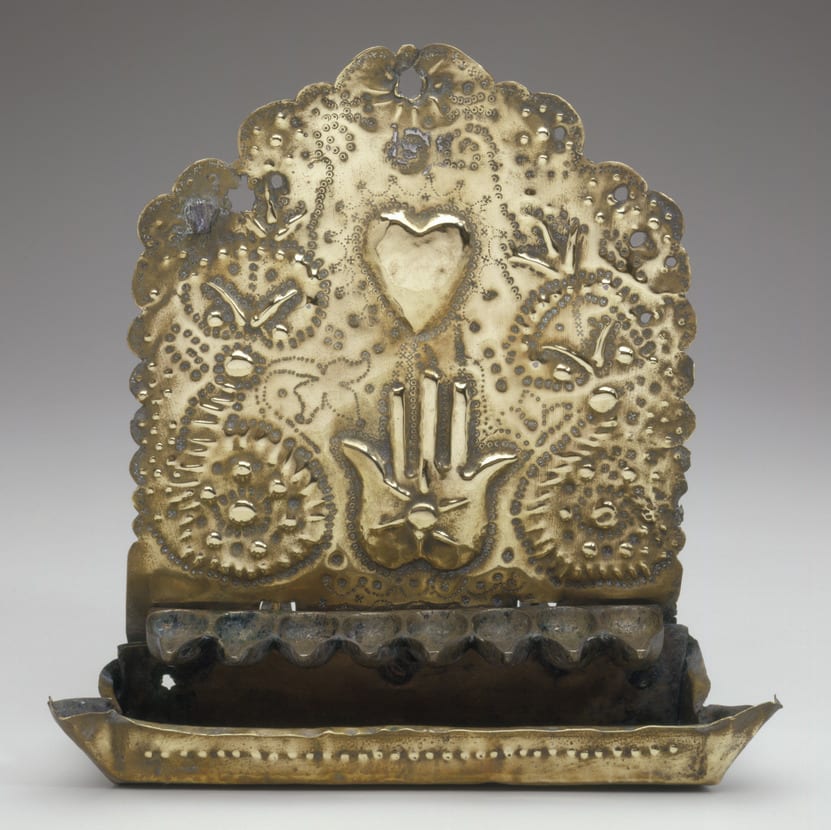
- Object Name:
- Hanukkah Lamp
- Place Made:
- Morocco
- Date:
- second half 19th century
- Medium:
- Copper alloy: repoussé, punched, and cast
- Dimensions:
- 11 × 11 × 4 in. (27.9 × 27.9 × 10.2 cm)
- Credit Line:
- Gift of Elaine D. Elmaleh
- Accession Number:
- F 2750a
Not On View
Repoussé sheet-brass lamps were common in Holland. However, a number of similar lamps were also purchased in Morocco. For lamps without provenance, it has therefore long been difficult to determine whether they were made in Europe or North Africa.
In an effort to resolve this difficulty, a study was undertaken of a group of sheet-metal lamps in the Joods Historisch Museum in Amsterdam, many of which were obtained in Holland, and a group collected in the late 1940s and 1950s by Zayde Schulmann in various cities of Morocco, now in the Israel Museum. An analysis of the types of metals, techniques of decoration, as well as of the construction and method of fastening the drip pan, showed few differences among the lamps from the two countries. The only factors that seemed to clearly distinguish them were the placement of the shamash, the methods used for suspension, and the types of oil containers used. Almost all the Dutch lamps had the shamash on the proper left side, while in Moroccan examples it was located in the top center. In addition, the Dutch lamps were suspended by a hole pierced in the top, while many Moroccan lamps had an additional sheet brass strip riveted to the backplate that held a suspension ring. Finally, some of the examples from Morocco had sheet-metal oil rows that were mounted on cylindrical shafts and attached to the drip pan. This is characteristically Moroccan, found on other types of Moroccan lamps as well. Cast oil containers were often the same shape in both countries, but those originating in Holland were made from different models than those found in North Africa.
The use of the Middle Eastern motif of the hand or hamsa in the center of the backplate of the museum's lamp, as well as the provenance, confirms that it is Moroccan made. According to museum records, the original owner of the lamp, Esther Elmaleh, came from a North African family.
In an effort to resolve this difficulty, a study was undertaken of a group of sheet-metal lamps in the Joods Historisch Museum in Amsterdam, many of which were obtained in Holland, and a group collected in the late 1940s and 1950s by Zayde Schulmann in various cities of Morocco, now in the Israel Museum. An analysis of the types of metals, techniques of decoration, as well as of the construction and method of fastening the drip pan, showed few differences among the lamps from the two countries. The only factors that seemed to clearly distinguish them were the placement of the shamash, the methods used for suspension, and the types of oil containers used. Almost all the Dutch lamps had the shamash on the proper left side, while in Moroccan examples it was located in the top center. In addition, the Dutch lamps were suspended by a hole pierced in the top, while many Moroccan lamps had an additional sheet brass strip riveted to the backplate that held a suspension ring. Finally, some of the examples from Morocco had sheet-metal oil rows that were mounted on cylindrical shafts and attached to the drip pan. This is characteristically Moroccan, found on other types of Moroccan lamps as well. Cast oil containers were often the same shape in both countries, but those originating in Holland were made from different models than those found in North Africa.
The use of the Middle Eastern motif of the hand or hamsa in the center of the backplate of the museum's lamp, as well as the provenance, confirms that it is Moroccan made. According to museum records, the original owner of the lamp, Esther Elmaleh, came from a North African family.
Information may change as a result of ongoing research.